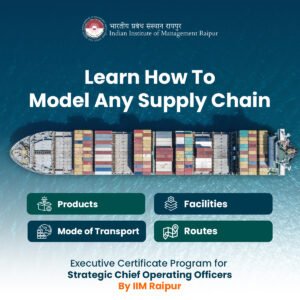In the fast-paced world of modern commerce, efficient supply chain management is the cornerstone of success. Companies are constantly seeking ways to optimize their operations, streamline processes, and reduce costs. One often overlooked yet critical aspect of supply chain management is network design.
The term "supply chain" represents a multifaceted logistics network comprising various facilities that transform raw materials into final products and efficiently deliver them to the ultimate destination—whether it's end consumers or valued customers.
Network design, the unsung hero behind the scenes, possesses the power to revolutionize the way businesses operate, optimizing processes and driving down costs like a savvy conductor orchestrating a flawless performance. Whether you're a logistics enthusiast, a business owner, or just someone curious about the intricate dance of commerce, this blog is your golden ticket to explore the hidden secrets of supply chain efficiency and cost reduction.
In this post, we will delve into how network design can significantly impact supply chain efficiency and cost. By the end, you'll have a comprehensive understanding of the role network design plays in the success of businesses.
Overview of Supply Chain Management
Supply Chain Management – it's not just a term; it's the conductor of a grand orchestra, the maestro of commerce, orchestrating the harmonious flow of goods and services in the global marketplace.
Imagine for a moment a mesmerizing symphony of interconnected players, each with its unique instrument, playing their part in the masterpiece of delivering products to your doorstep, ensuring the shelves stay stocked, and your favorite online store remains your go-to haven.
-
The Composers of Commerce
At the heart of this epic symphony, you find the composers: suppliers, manufacturers, and distributors. They are the virtuoso composers, each adding their unique notes to the score. They source raw materials, craft the products, and dispatch them like musical notes on a staff, contributing to the rhythm and melody of the supply chain.
-
The Orchestra of Logistics
Picture the orchestra with trucks, planes, and ships as instruments. These are the logistics wizards, the swift and agile performers that ensure the instruments are in tune and the tempo is just right. They transport goods across vast distances, making sure your favorite coffee beans or smartphone components reach you in pristine condition.
-
The Synchronized Dancers
Then, there are the synchronized dancers – the warehouses and distribution centers. These are the ballerinas in the production, ensuring every piece is in its place, ready to take the spotlight when its time arrives. They twirl and leap, with impeccable timing, in this mesmerizing ballet of supply chain management.
-
The Conductors of Data
In the digital age, data reigns supreme. The conductors of data are the analytical minds behind the scenes, wielding the baton of information to make informed decisions. They read the sheet music of data, knowing when to increase production, alter shipping routes, or replenish stock. Their role is critical, ensuring that the symphony is manageable.
-
The Melody of Customer Demand
The audience's applause in this symphony is the sweet sound of customer demand. It's the audience's desire for specific products that keeps the performance alive and vibrant. Each purchase represents a standing ovation, a testament to the skillful execution of supply chain management.
-
Harmony and Discord
Like any grand performance, the symphony of supply chain management is not without its moments of tension and discord. Supply disruptions, unexpected delays, and market fluctuations are like an out-of-tune instrument in an otherwise perfect ensemble. Yet, the mark of a truly skilled conductor is to overcome these challenges and ensure the music goes on.

Navigating the Digital Tapestry: The Art of Network Design
Imagine for a moment that you're an architect of a city, but instead of bricks and mortar, your canvas is a virtual world of connections and data. This is what network planning is all about – crafting the digital metropolis where data flows seamlessly, much like the intricate web of a spider, connecting everything in a symphony of online connectivity.
In this digital age, network design is the architect, the artist, and the visionary of our interconnected world.
-
The Architect of Connectivity
Network design is not about mere wires and cables; it's about sculpting the pathways through which information zips across the globe. It's the blueprint of the city, deciding where the roads and highways will be ensuring a smooth flow of data traffic.
-
Building the Digital Roads
Picture a city's roads – some are busy highways, some are quiet lanes. Network design works similarly. It's all about creating the right lanes for data, allocating bandwidth, and setting up routes that ensure your Netflix stream remains uninterrupted and your Zoom call stays crystal clear.
-
The Bridge Builders
In this digital city, the bridges that connect different neighborhoods are like routers and switches. These devices are the unsung heroes, making sure data packets traverse from one side of the river to the other, allowing you to send that urgent email or post a cute cat video without a hitch.
-
The Traffic Directors
You can only have a city with traffic rules and signals. Network design sets up protocols and security measures to direct the flow of data. It's like having traffic lights at every intersection, ensuring that your data doesn't collide or take a wrong turn.
-
The Artists of Efficiency
A network designer is like a skilled artist seeking to optimize and fine-tune the network's performance. They strive to make sure that data flows efficiently, minimizing congestion and ensuring that your digital world remains a smooth and seamless experience.
-
Invisible Weavers of the Web
Network design often goes unnoticed, much like the invisible web that connects the internet. It's always there, working behind the scenes, ensuring that when you click a link or send a message, it reaches its destination just like magic.
-
The Future Visionaries
In a world that's constantly evolving, network designers are the visionaries. They anticipate future needs and trends, adapting the digital city to accommodate the next wave of technological innovations. They ensure that our digital world keeps growing, expanding, and adapting to our changing needs.
How Network Design Affects Supply Chain Efficiency?
Efficiency is the lifeblood of any supply chain streamlining, and network design is a potent tool for achieving it.
-
Finding the Optimal Network Configuration
Imagine your supply chain as a spider's web, with nodes representing different facilities, warehouses, and distribution centers. The first step to enhancing efficiency is finding the optimal configuration. This involves determining the ideal locations and capacities for these nodes. Network design in the supply chain can help streamline this process, considering factors like customer demand, transportation costs, and service levels.
-
Streamlining Transportation Routes
Once your network configuration is optimized, the next step is to streamline transportation routes. Think of this as mapping out the quickest and most cost-effective paths for your goods to travel from point A to point B. Advanced route optimization algorithms can help minimize fuel consumption and reduce transportation time, all of which contribute to efficiency gains.
-
Inventory Optimization
Efficiency isn't just about getting goods from one place to another—it's also about managing inventory effectively. The right network design helps in achieving optimal inventory levels across the Cost-effective supply chain. By ensuring that each facility holds the right amount of inventory, you can reduce carrying costs while still meeting customer demands.
-
Real-time Data and IoT Integration
In today's interconnected world, real-time data is invaluable. Integrating Internet of Things (IoT) technology into your supply chain allows you to monitor the status and condition of goods as they move through the network. This data can be used to make on-the-fly adjustments, minimizing disruptions and keeping your supply chain humming along smoothly.
How to Reduce Cost with Network Design?
Cost reduction is a primary goal for many businesses, and network design can be a strategic approach to achieve this goal.
-
Cutting Transportation Costs
Optimizing transportation routes not only increases efficiency but also cuts transportation costs. Fewer miles traveled, less fuel consumption, and minimized wear and tear on vehicles all lead to significant savings. This is a win-win for both your business and the environment.
-
Minimizing Overhead
A well-designed network can minimize overhead costs. By consolidating warehouses or distribution centers and streamlining operations, you can reduce staffing, utility, and maintenance expenses. This not only saves money but also simplifies your supply chain structure.
-
Improved Demand Forecasting
Network design isn't just about physical logistics; it's also about data analysis. Advanced analytics tools can help improve demand forecasting. By understanding customer behavior and market trends, you can align your supply chain with actual demand, reducing the risk of overstock or understock situations.
-
Supplier Collaboration
Collaboration with suppliers is crucial in supply chain efficiency. When you design your network with supplier locations in mind, you can reduce lead times and transportation costs. Moreover, fostering strong relationships with suppliers can lead to cost savings through bulk purchasing and shared resources.
The Final Words
Network design is the hidden hero in the realm of Sustainable supply chain design. It can significantly impact both efficiency and cost reduction. Remember, it's not a one-time effort. A well-designed network requires constant monitoring, adaptation, and integration of the latest technologies. In doing so, businesses can stay ahead of the curve and continue to improve their supply chain efficiency while reducing costs.
Imarticus Learning and IIM Raipur have joined forces to craft an exclusive executive certificate program tailored for visionary Chief Operations Officers. This transformative program paves the way for the emergence of strategic Chief Operations Officers, equipping them with essential strategic, operational, personal, and technological proficiencies. For 10 months, this chief operating officer course unfolds a world of possibilities.
Within its comprehensive 10-month duration, participants will immerse themselves in over 150 hours of captivating interactive sessions, all expertly guided by the accomplished faculty of IIM Raipur. This operations management certification is not merely a learning experience; it is a transformative journey that will empower you to master the pivotal skills required in this dynamic domain, propelling you toward the coveted C-suite roles of leadership.









